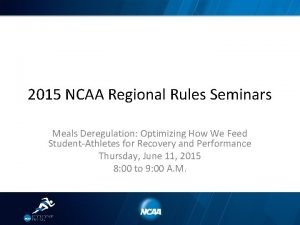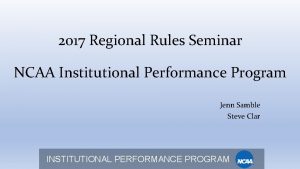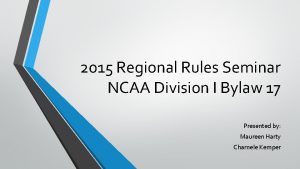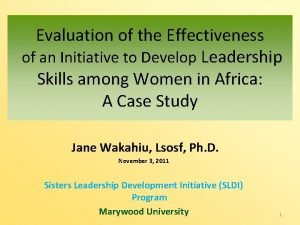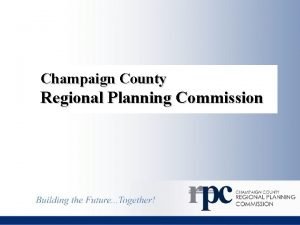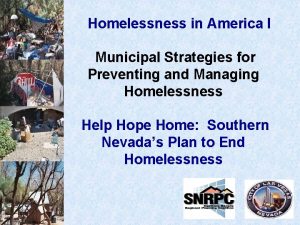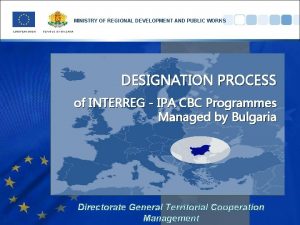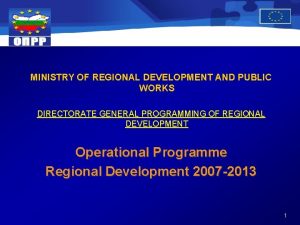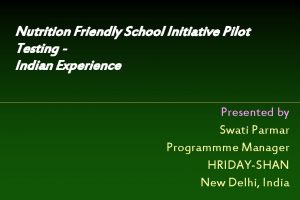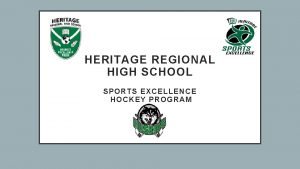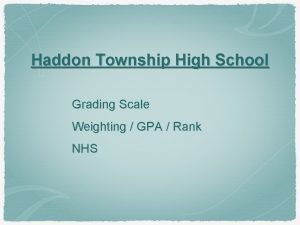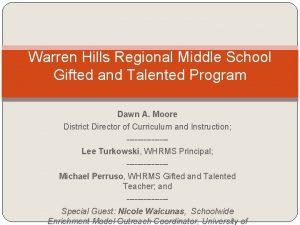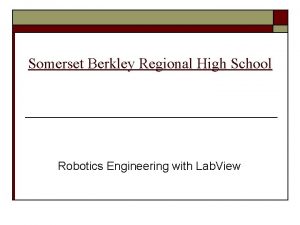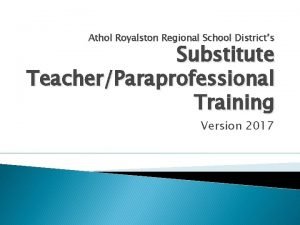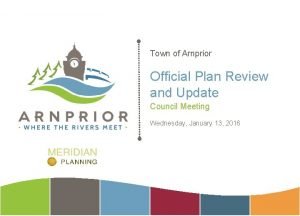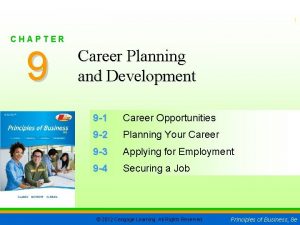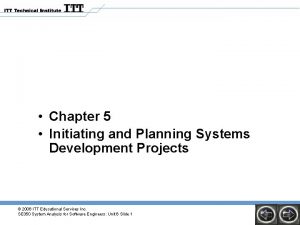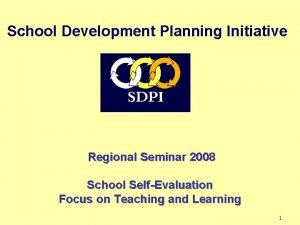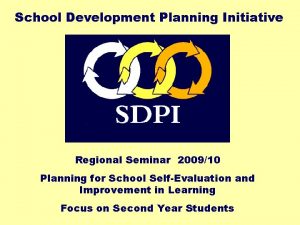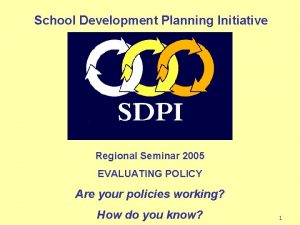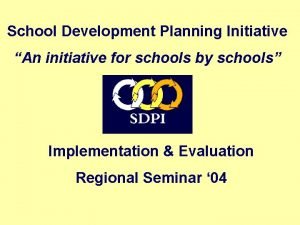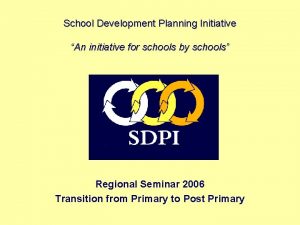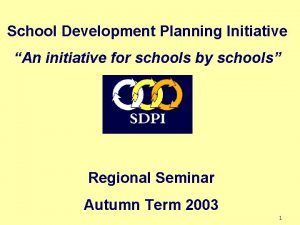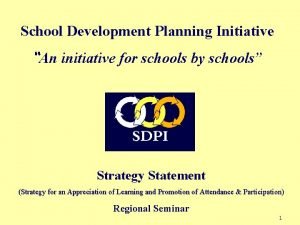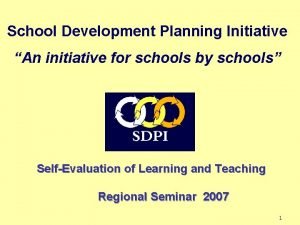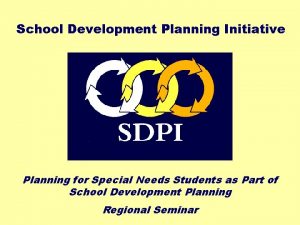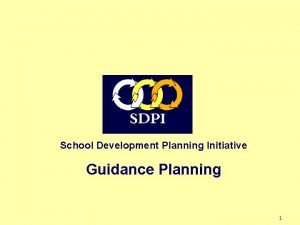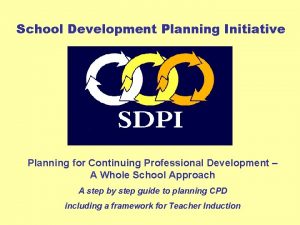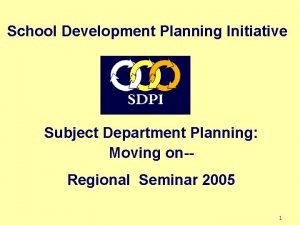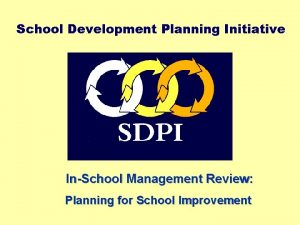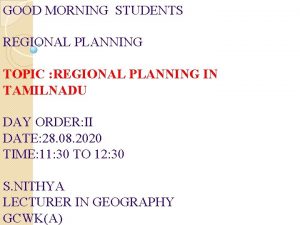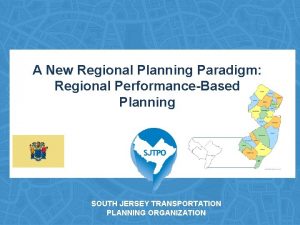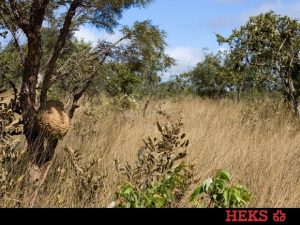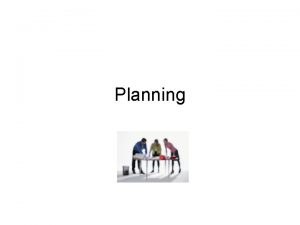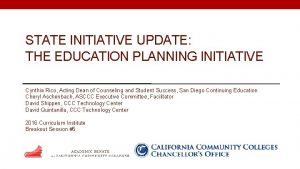School Development Planning Initiative Regional Seminar 2008 School








































- Slides: 40

School Development Planning Initiative Regional Seminar 2008 School Self-Evaluation Focus on Teaching and Learning 1

Purpose To focus on self-evaluation as a strategy for improving the quality of teaching and learning: Specifically: n to explore how to foster a self-evaluation approach to teaching & learning as part of subject planning and on-going school review 2

U. K. . . SDP Research n SDP does not automatically lead to school improvement n Needs to have focus on teaching and learning and pupil achievement (Mac. Gilchrist et al, 1995) 3

Self-evaluation of teaching and learning Issues to consider: n Quality of student engagement n Quality of learning experience n Classroom climate 4

Discussion “When I go into a classroom where the quality of learning is high, I see…” (Hesketh, 2008) 5

What teaching techniques help students to learn? (% very helpful) n Teachers explain well (72%) n Can have fun (41%) n Express an opinion (36%) n Group work with friends (30%) n Practical work (30%) n Copy notes (29%) n Find things out (25%) n Teacher instruction (18%) (ESRI /NCCA) 6

Focus on Self-Evaluation 7

Approaches to Self-Evaluation: - key aspects A. Opportunity to Self-Evaluate: Individual Subject Dept Staff B. Process of Self-Evaluation: Current Practice Improved Practice C. Success Criteria – Outcomes Student Engagement Achievement Gains 8

What is Self-Evaluation of Teaching/ Learning? n Systematic, evidence-based inquiry into an aspect of teaching &learning n Seeks to find out how well the subject department/teacher is doing in relation to accepted standards of good practice n Guides the teacher/subject department to select planning priorities for improvement 9

Self-Evaluation of Teaching and Learning n Can/should form part of developmental focus of subject departments n Can be done by individual teacher to support a reflective practice approach to improving learning and teaching n What is your experience to date? 10

Areas which Subject Departments/Teachers could focus on for Self-Evaluation n n Learning outcomes Success criteria Pace Questioning Literacy strategies e. g: use of key words Differentiation Assessment/homework Classroom organisation Teacher-student relationship Group work/pair work 11

Process of Self-Evaluation –key steps Regarding a selected area: n Determine what good practice is n Gather reliable data on actual practice n Collate and interpret the data - evidence n Reach valid conclusions that you can stand over n Prioritise for planned improvement 12

The Tools of Self-Evaluation ■ Questionnaires ■ Interviews ■ Observation ■ Analysis of pupils’ work ■ Spot checks ■ Critical incident analysis ■ Force field analysis ■ Posters, stickies, exit tickets ■ Photo inquiry See Unit 5, SDP Draft Guidelines (p. 21 -24) 13

Engaging with students as part of self-evaluation Three sample instruments to use: n Force field analysis n Sport check n Questionnaire on teaching methodologies The following three slides are taken from Mc. Beath, 2005, The Self-Evaluation File 14

The Force Field 15

Evaluating Classroom Climate 16

Questionnaire on teaching methodologies: How frequently do I use this approach? How well does it help you to learn? n n n Listening to the teacher Answering teacher’s questions Doing experiments Working on the computer Watching a video Listening to a tape Acting out a role play Working in a group Taking notes while the teacher talks Taking notes from a book or worksheet Making things (Mac. Beath, 2005, pp 26 -28) 17

Quality of Teaching and Learning (Area 4, Looking at Our School) Methodology § Appropriate methodologies § Clarity of purpose § Pace and structure of lesson § Variety of strategies § Use of resources Classroom management § Discipline § Management of learning activities § Challenge & motivation Classroom atmosphere § § Respect Interactions Environment Affirmation Learning § § Engagement Understanding Knowledge and competence Collaborative/independent learning § Communication 18

Quality of Teaching and Learning (Area 4, Looking at Our School) n Aspect B: Teaching and Learning n Component iv: Learning n Theme: “How actively and independently students engage in learning, and how the quality of their understanding is reflected in their questioning and in their responses to questions” 19

Focus on Questioning A Teaching and Learning Strategy 20

Buzz • What is the purpose of your questions during any class? 21

Why do we ask questions? n To develop interest and motivation n To evaluate students’ preparation and preknowledge n To identify, difficulties or blocks to learning n To stimulate pupils to ask questions n To stimulate independent learning n To check on homework / class work n To develop critical thinking / inquiry skills n To evaluate achievement 22

What is required of students when they are asked a question? n The student has to: o Attend/listen/absorb the question o Decipher the meaning o Generate a covert response (i. e. , formulate a response in one’s mind) o Generate an overt response … and perhaps revise the response due to further teacher probing o Reflect and learn through discussion 23

Wait-Time: After posing a Question n Average wait-time is 1 second n Increasing the wait-time to 3 seconds or more after posing a lower order Q is related to achievement gains n There appears to be no wait-time threshold for higher order Q’s. But the longer the wait-time, the better the student engagement 24

What type of questions do you ask? (See Bloom’s Taxonomy of Questioning) n Knowledge n Comprehension n Application n Analysis n Synthesis n Evaluation 25

Planning for Questioning Adapted from E C Wragg Identify the key questions in relation to the learning intentions for the lesson Decide on the level, order and timing of questions Extend the questioning - thinking of subsidiary questions to ask Analyse anticipated answers and responses you might give 26

Classroom Questioning Issues to consider 1. 2. 3. 4. 5. 6. 7. 8. 9. 10. Identify current range/variety of questions Cognitive requirement – recall or creative/evaluative Wait time 1 and wait time 2 How is respondent chosen? Answers formulated by pairs, groups etc ‘No hands’ answering How are ‘incorrect answers’ dealt with? Answering ‘culture’ of classroom – ‘safe’ to answer How are ‘questioning sessions’ built upon? Questions constructed by students – (incl test Q’s) 27

Process of Self-Evaluation Key steps regarding questioning: n Determine what good practice in questioning is n Gather reliable data on your actual use of questioning (How would you do this? ) n Collate and interpret the data you have gathered about your use of questioning - evidence n What conclusions can you reach from this evidence about your use of questioning n Prioritise new approaches for planned improvement 28

Workshop Having implemented changes in your approach to questioning over time how would you evaluate its effectiveness? n What evidence/indicators might you look for to indicate that new approaches were making a difference? 29

Improved Questioning Strategies: Indicators/Outcomes n Questioning strategy in place – (frequency, ability appropriate, HO, LO, etc) n Greater student engagement - (greater participation in oral questioning routines) n Weaker students more responsive n More able students using more higher thinking skills n Improvements in achievement – gain in test scores n Less class disruption n Superior engagement re Homework n Improved quality Homework n Positive teacher-student interaction n Greater teacher satisfaction n Other? 30

How can you promote/embed a self-evaluation approach to teaching and learning in your school? n Encourage each department to select an area for development/evaluation each year n Explore what a systematic approach to self-evaluation would look like with staff n Emphasise the importance of using research/ theory on the chosen area n Encourage a collaborative approach – sharing theory, developing common evaluation instruments, using peer observation n Identify pockets of good practice and find ways of sharing these n Encourage each department to give a report to colleagues on the outcomes of the evaluation process – what the department learned as a result of their work 31

Additional Materials 32

NCCA/ESRI: Gearing up for the Exam Aspects of student experience which generated positive interactions with teachers n Being able to ask questions in class n Being praised for answers in class/ good written work n Being treated fairly and with respect n Positive feedback n Consulting students about their learning/ issues that relate to their school experience n Including them in decision-making process 33

NCCA/ESRI: Gearing up for the Exam Aspects of student experience which generated negative interactions with teachers n Not receiving any positive feedback on their work n Being given out to frequently for misbehaviour in class or not having their work done n Not enough encouragement or challenge to maintain interest/engagement n Favouring one student over others (being less strict on girls than boys) More than 10%students did not find school work interesting 34

Classroom Strategies To encourage students to participate and to deal with pupils’ answers productively consider the following: To help pupils to generate their own questions: n Think, pair, share, square n Model questioning for pupils. n Prompt pupils n Provide opportunities for n Use a pupil’s wrong answer to pupils to practice their skills. develop understanding. n Plan time for pupils’ n Involve more than one questions and for dealing student / whole class in the with them effectively. answer n Listen and respond positively. (pause, prompt, praise) 35

Question Stems n n n n n How can we be sure that. . . ? What is the same and what is different about …? Is it ever/always true/false that …? Why do ____, ____ and ____ all give the same answer? How do you …. ? How would you explain …? What does that tell us about …? What is wrong with …? Why is _____ true? 36

Some general findings on questioning n Posing questions during lessons is more effective in producing achievement gains than lessons without questions n Oral questioning during class is more effective in fostering learning than written questions n Questions that focus on key/salient elements promote better comprehension n Asking questions frequently during class discussions is positively related to learning facts 37

Further findings n With weaker ability groups – the frequent use of lower order questions is positively associated with achievement n Increasing the use of higher order questioning (beyond 20%) produces learning gains n Increasing the use of higher order questioning to 50% enhances teacher expectation in relation to those regarded as slow/poor learners 38

Quality of learning in the classroom? (John West Burham) SHALLOW DEEP (WHAT) (HOW) PROFOUND (WHY) MEANS Memory Reflection Intuition OUTCOMES Information Knowledge Wisdom EVIDENCE Replication Understanding Meaning MOTIVATION Extrinsic Intrinsic ATTITUDES Compliance Interpretation Creativity RELATIONSHIPS Dependence Interdependence Independence Authentic 39

Sample Comments – SI Reports 08 n …written, oral, and pictorial questioning n …questions were directed at specific students n …students were given time to formulate their answers and were encouraged to put up their hands before a respondent was chosen 40
 2008 2008
2008 2008 Ncaa regional rules seminar
Ncaa regional rules seminar Ncaa regional rules
Ncaa regional rules Ncaa regional rules seminar
Ncaa regional rules seminar Northern waterfront economic development initiative
Northern waterfront economic development initiative Sisters leadership development initiative
Sisters leadership development initiative What is regionalization
What is regionalization Champaign county regional planning commission
Champaign county regional planning commission Location planning in operations management
Location planning in operations management Helphopehome
Helphopehome Headwaters regional development commission
Headwaters regional development commission Ministry of regional development and public works
Ministry of regional development and public works Ministry of regional development and public works
Ministry of regional development and public works Entrepreneurship and regional development
Entrepreneurship and regional development Nutrition friendly school initiative
Nutrition friendly school initiative School safety
School safety 2008-2009 school year
2008-2009 school year 2008 middle school fashion
2008 middle school fashion Waukegan high school counselors
Waukegan high school counselors Heritage regional high school hockey
Heritage regional high school hockey Highest weighted gpa
Highest weighted gpa Warren hills regional middle school
Warren hills regional middle school Somerset berkley regional high school
Somerset berkley regional high school Freehold regional school district employment
Freehold regional school district employment Athol-royalston regional school district
Athol-royalston regional school district Northern burlington county regional school district
Northern burlington county regional school district Strategic planning vs tactical planning
Strategic planning vs tactical planning Goal achievement matrix
Goal achievement matrix Role segmentation workforce planning
Role segmentation workforce planning N planning
N planning Aggregate planning is capacity planning for
Aggregate planning is capacity planning for Long medium and short term planning in primary schools
Long medium and short term planning in primary schools Corpus planning and status planning slideshare
Corpus planning and status planning slideshare List the strategic objectives of aggregate planning
List the strategic objectives of aggregate planning Examples of aggregate planning
Examples of aggregate planning Retail future development arnprior
Retail future development arnprior Chapter 9 career planning and development
Chapter 9 career planning and development Creative strategy planning and development
Creative strategy planning and development Product planning and development
Product planning and development New product planning and development
New product planning and development Initiating and planning systems development projects
Initiating and planning systems development projects

